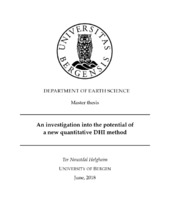| dc.contributor.author | Helgheim, Tor Naustdal | |
| dc.date.accessioned | 2018-08-16T14:26:46Z | |
| dc.date.available | 2018-08-16T14:26:46Z | |
| dc.date.issued | 2018-06-22 | |
| dc.date.submitted | 2018-06-21T22:00:13Z | |
| dc.identifier.uri | https://hdl.handle.net/1956/18122 | |
| dc.description.abstract | The seismic response of a layer boundary is dependent on a variety of geological factors and is likely to vary significantly along a given reflector. An aspect that seems to be underutilised in the current DHI methods is that the contrast in seismic response across a fluid contact is less likely to vary significantly. Likewise, it appears that amplitude variations at the top reservoir reflector due to the tuning between the top reservoir and the fluid contact and the strength of intra-reservoir reflectors are not fully utilised in the current DHI methods. This thesis includes modelling the expected variations in amplitude and AVO response across a fluid contact along a given top reservoir reflector, and development and testing of DHI-finding algorithms with data from the Luva and Gullfaks fields. The modelling was based on well logs and included modelling of the tuning effect between the top reservoir reflector and the fluid contact. The algorithms were designed to search along seismic reflectors for the amplitude and AVO response that was expected across a fluid contact based on the modelling. The result of the testing demonstrates that the algorithms are able to locate the fluid contact in many areas. The results are affected by several elements, and the most significant are the effects of erosion, onlapping layers, tuning, the presence of faults and the quality of the seismic data and interpretation. The AVO results are less consistent than the amplitude results, but in some areas, the results from the AVO algorithm and the amplitude algorithm agree and hence increases the reliability of the results. Based on the lessons learned while developing the algorithms and the experience gained from testing them at Luva and Gullfaks, it is concluded that the developed methods have the potential to be a valuable addition to the current DHI methods. Further improvements to the methods can be made by including more attributes, extend the methods to work in settings where the reservoir position is unknown and systematically test the methods against real data. | en_US |
| dc.language.iso | eng | eng |
| dc.publisher | The University of Bergen | en_US |
| dc.subject | geophysics | eng |
| dc.subject | AVO | eng |
| dc.subject | MATLAB | eng |
| dc.subject | seismic attributes | eng |
| dc.subject | direct hydrocarbon indicators | eng |
| dc.subject | DHI | eng |
| dc.subject | amplitude | eng |
| dc.subject | Seismiske bølger | nob |
| dc.subject | Seismiske metoder | nob |
| dc.subject | Seismisk oljeleting | nob |
| dc.subject | Seismisk refleksjon | nob |
| dc.title | An investigation into the potential of a new quantitative DHI method | en_US |
| dc.type | Master thesis | |
| dc.date.updated | 2018-06-21T22:00:13Z | |
| dc.rights.holder | Copyright the Author. All rights reserved | en_US |
| dc.description.degree | Masteroppgåve i geovitskap | en_US |
| dc.description.localcode | MAMN-GEOV | |
| dc.description.localcode | GEOV399 | |
| dc.subject.realfagstermer | https://data.ub.uio.no/realfagstermer/c000962 | |
| dc.subject.realfagstermer | https://data.ub.uio.no/realfagstermer/c006706 | |
| dc.subject.realfagstermer | https://data.ub.uio.no/realfagstermer/c008498 | |
| dc.subject.realfagstermer | https://data.ub.uio.no/realfagstermer/c000624 | |
| dc.subject.nus | 756199 | eng |
| fs.subjectcode | GEOV399 | |
| fs.unitcode | 12-50-0 | |
